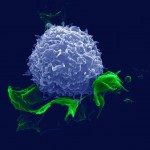Lien vers Pubmed [PMID] – 23121366
J. Viral Hepat. 2012 Dec;19(12):872-80
A new hepatitis B virus (HBV) protein, hepatitis B splice-generated protein (HBSP), has been detected in liver biopsy specimens from patients with chronic active hepatitis. The aim of this study was to characterize the phenotype and functions of peripheral HBSP-specific T cells and to determine whether these T-cell responses may be implicated in liver damage or viral control. Two groups of patients were studied: HBV-infected patients with chronic active hepatitis and HBV-infected patients who were inactive carriers of hepatitis B surface antigen. HBSP-specific T-cell responses were analysed ex vivo and after in vitro stimulation of peripheral blood mononuclear cells. Soluble cytokines and chemokines were analysed in sera and in cell culture supernatants. Few HBSP- or capsid-specific T-cell responses were detected in patients with chronic active hepatitis whereas frequency of HBV-specific T cells was significantly higher in inactive carrier patients. HBSP activated CD8+ and CD4+ T cells that recognized multiple epitopes and secreted inflammatory cytokines. The IL-12 level was significantly lower in sera from asymptomatic carrier patients compared to patients with chronic active hepatitis. IL-12 and IP-10 levels in the sera were significantly and independently correlated with both alanine amino transferase and HBV DNA levels. Our results show that the HBSP protein activates cellular immune responses in HBV-infected patients but has probably no prominent role in liver damage. The pattern of cytokines and chemokines in sera was linked to HBV viral load and was consistent with the level of inflammation during chronic hepatitis.

